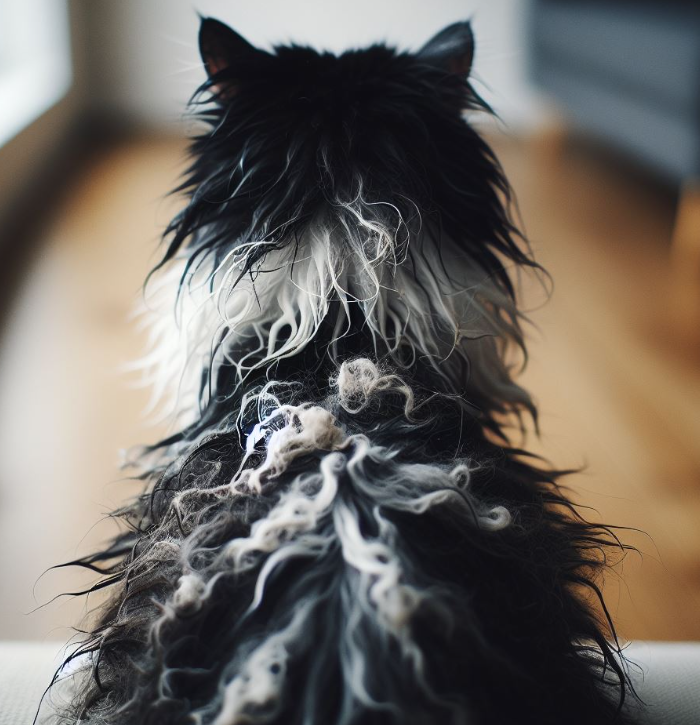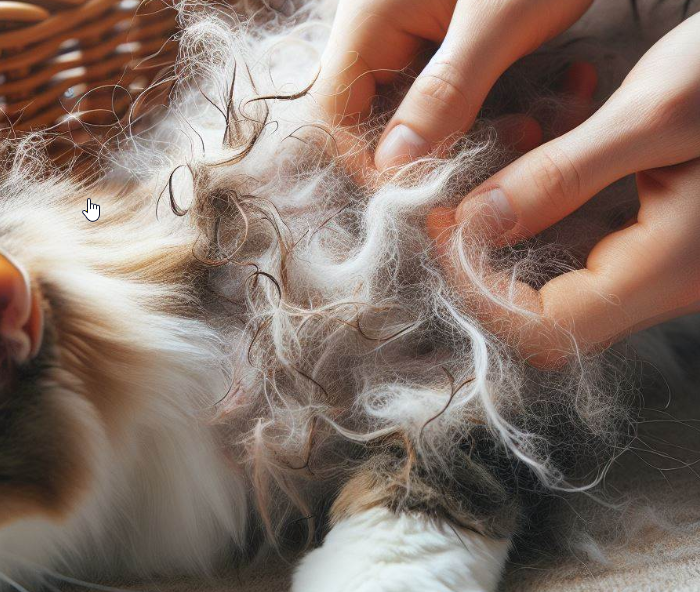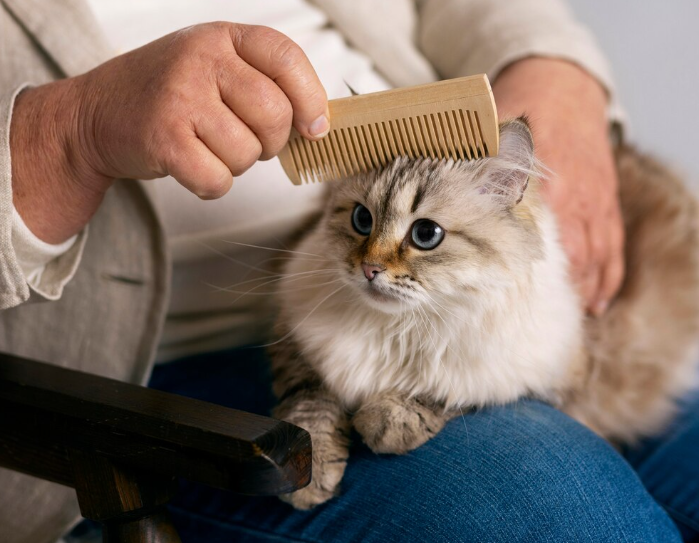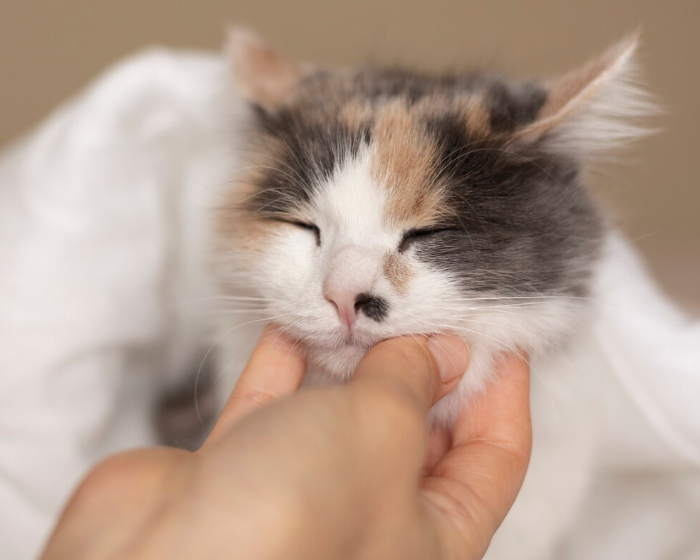2024-02-26
We often refer to our cats as “furry friends”, “cute balls of fur”, or “fluffy sweethearts” (even though they occasionally show their temperament and sharp teeth). All these loving ways to call our kitties show how important their fur is— not only for them but also for us as owners.
Cat fur does not only serve as a tool for protection, isolation, communication, and camouflage but is also highly appreciated by humans for its uniqueness in terms of texture and color. It makes felines look incredible and beautiful- just like we perceive them! And, of course, it causes the urge in many people to want to cuddle with them!
Since our felines’ fur plays such an essential role, it is important for us as caring cat parents to take care of it and prevent it from becoming matted. Although cats spend much of their time awake in grooming, having matted hair is not something uncommon.
Let’s find out what the causes of matted hair in cats are and what we can do to stop it!

When we talk about “matted hair” in cats, we refer to tangled clusters of fur that form from loose hairs, which have become knotted and intertwined.
These knots vary in size and severity and can be small tangles or dense clusters that are difficult to separate.
Most often, matted fur occurs in areas, that cats groom less frequently, such as behind the ears, the tail, the sanitary area, back, and rear legs.
Even if matted hair does not sound like a serious issue, it can actually have many negative side effects and should be addressed on time.
Matted hair can cause discomfort in your cat and even lead to health problems if left untreated, as it can pull on the skin, and trap moisture. This, in turn, will help create a ground for bacteria or parasites to develop. Needless to say that foreign objects, and substances, including dirt and debris, can stick to it and spread into your home. This might cause many health issues in more sensitive people or individuals with allergies.
There are several common causes of matted fur in cats.
Cats are known for their impeccable hygiene and grooming habits. According to many veterinarians, healthy home cats basically do not need to be bathed, unless, of course, they go outside and are exposed to other animals and factors in their environments.
In certain cases, felines might become unable to properly groom themselves, which will likely cause their fur to become matted in some areas. For example, health conditions like arthritis, and obesity, can limit a cat’s ability to effectively reach all body areas.
Aging is another factor that can contribute to neglecting the grooming routine in cats, as it is typically accompanied by reduced mobility and energy levels.
Do you like long-haired cat breeds such as the Persian cat, the Maine Coon, the Himalayan cat, the Birman, the British Longhair, etc.? They are fascinating, aren’t they?
However, along with the time to cherish their wonderful fur, you will also need to spend much time taking care of it. There is a higher likelihood for tangles and knots to build in long-haired cats compared with their short-haired counterparts.
If you are considering getting a cat of a long-haired breed, always think of the time and effort you can put into maintaining their fur.
Does your cat live outdoors? Or maybe you let your indoor kitty go outside and explore the backyard or even the neighborhood? Cats are natural explorers, so it is not uncommon for cat owners to give their fur babies the freedom to explore (preferably in a controlled environment).
There is a disadvantage of this type of life, though- your cat is at risk of getting their fur wet, and more prone to tangling and matting. Also, there is a higher risk for dirt, and other substances to get stuck to their fur.
Needless to say, if your feline tends to roam freely, you need to have them regularly vaccinated and protected against parasites. Regular vet check-ups should be included in your to-do list when it comes to cat care.
Skin conditions, parasites, injuries, or more serious underlying health issues can cause your cat to avoid grooming certain areas, which may lead to mat formation.
Dermatitis and allergies, may cause discomfort or irritation, prompting your fur buddy to avoid grooming certain areas of their body.
Parasites, such as fleas and mites, can also interfere with your kitty's grooming habits and lead to mat formation. Cats with parasites are more likely to focus on scratching and self-soothing rather than grooming.
Additionally, injuries or wounds may cause pain or sensitivity, which makes cats reluctant to groom the affected areas. This might cause mats and knots to develop over time.
As mentioned above, older cats or those with mobility issues, such as arthritis or joint pain, may struggle to reach certain parts of their body for grooming. This will likely lead to matting in the areas that are neglected or more difficult to access.
If this is the case with your feline, you should make sure to support them during grooming sessions and help them alleviate discomfort and reduce the risk of mat formation.

If you have to deal with matted cat fur, it is essential to address the issue promptly to prevent it from becoming serious and leading to discomfort or even an underlying health condition.
Regular brushing is crucial to preventing mats from building up and keeping your cat's fur smooth and tangle-free.
It is recommended that you use a suitable brush or comb based on your cat's coat type, and make brushing sessions a part of your routine. When brushing your feline, try to remove loose hair very gently to prevent knots from forming.
For long-haired breeds, such as the breeds listed above, daily brushing may be necessary to keep their fur smooth and neat. Short-haired breeds do not need as frequent brushing as long-haired felines, however, they will also benefit from brushing every week or two. Always keep track of your cat’s hair condition along with their overall well-being.
For small mats, you might gently separate them by using your fingers or a wide-toothed comb. Start from the outer edges of the mat and patiently work your way inward, avoiding pulling.
It is essential to be very patient and gentle to help your cat associate the brushing sessions with a pleasant experience.
Rewarding your kitty with their favorite treats during the brushing sessions will reinforce the positive experience and make them more tolerant of it over time.
Do not force your feline if you notice that they are feeling uncomfortable or even stressed. Give them time to get accustomed to the brushing procedure and be calm and relaxed.
In cases of moderate to severe matting, specialized tools such as mat splitters, detangling sprays, and de-matting combs can help loosen knots and make them easier to remove.
If you opt for the spray, keep in mind that you should apply a small amount of it to the affected area only and then gently use the specialized mat splitter or de-matting comb. Be extra careful and gentle and do not hesitate to reach out to a groomer or veterinarian for assistance, if you are not feeling confident.
For severe mats that seem impossible to remove, seeking the assistance of a professional may be necessary! Do not put your cat’s health at risk, especially if you are not experienced in this field. Professional groomers have the expertise, experience, and specialized tools to safely and effectively remove mats without causing stress or discomfort to your cat. They can also give you advice on how to properly maintain your feline’s fur based on their specific needs.
In certain cases, there might be nothing else to do than shave the affected area…Please, consider this option only as a last resort and always seek the guidance of an experienced groomer or a veterinarian.
In case shaving or trimming might be needed, you do not need to worry about your cat’s hair! These procedures will not only help remove mats but will aid skin hygiene and reduce the risk of infections. And, of course, your feline’s hair will grow again!

By incorporating preventative measures into your cat's grooming routine you will minimize the risk of hair matting in the future.
Regular brushing and combing will help keep your cat’s fur clean and neat, remove loose hair, and prevent knots from accumulating. This is particularly valid for long-haired breeds.
You should pay attention to the areas prone to matting, such as behind the ears, under the chin, belly, sanitary area, etc. These areas are more prone to tangles and knots due to friction, moisture, and limited grooming access, so spending some extra time brushing them through might be helpful.
If you stay proactive and consistent with grooming, you can keep your cat's coat smooth, shiny, and free of tangles!
Regular Trimming
Regular trimming of your cat's fur, especially in long-haired breeds, helps prevent excessive matting and keeps the coat in optimal condition.
It is advisable to use blunt-tipped scissors and be extra careful to not cut your feline’s skin. Additionally, keeping your cat's nails trimmed reduces the risk of being scratched or of the professional being scratched during grooming.
Taking care of your cat’s fur is necessary but not the only condition to ensure they will have a nice, clean, and tangle-free coat.
Keeping their living environment clean and tidy also plays an important role in preventing dirt and moisture from accumulating. This, in turn, will reduce the risk of matting.
Regularly vacuuming carpets and upholstery, washing bedding and blankets, and cleaning your cat’s food and water bowls, will also reduce the presence of loose hair and environmental factors that can lead to mat formation.
Last but not least, you should provide your cat with a clean, and dry space to rest and groom themselves comfortably.
A balanced diet rich in essential nutrients is vital for maintaining your cat's skin and coat health.
Provide your cat with high-quality food that will support their skin and coat health along with the other essential nutrients, they need to be healthy.
Proper hydration and access to fresh water every day are also important, are also factors for keeping your cat’s hair shiny and neat.
Keep a close eye on your cat's overall health and behavior, as underlying medical issues can impact grooming habits and coat condition.
Do not neglect regular veterinary check-ups to address any potential health issues in a timely manner. Early detection and treatment are essential for maintaining your cat's well-being and preventing mat formation.